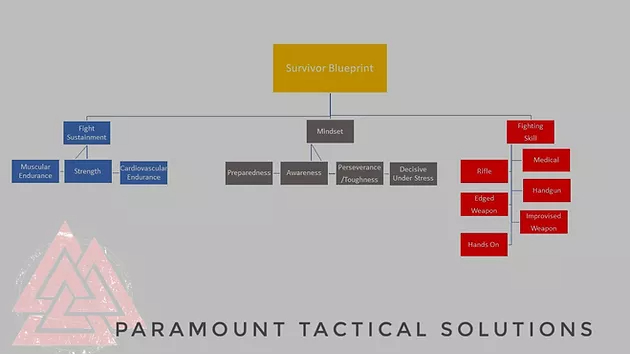
At our last Karambit course with Steve Tarani, Steve invited Douglas Esposito, the owner of Vanguard Gym, to talk about the Survivor Mindset. Doug referenced a study that discussed the commonalities of survivors of violent encounters.
The 3 determining factors were in Doug’s words “Gas (ability to sustain the fight), Mindset, and Skills.”
I’ve heard this presented a few times in different ways but I’ve been thinking a lot about this a lot. If we accept this concept as truth (and I do based on personal experience regardless of a study), then we as training professionals should be using this concept more effectively to prepare those that are serious about being effective defenders and more self reliant.
This model should be better utilized to provide a pathway to prioritize training and develop more well-rounded defenders.
When we look at the “skills” needed to give us the best chance of surviving lethal encounters, we need to identify each skill, that based on reality, would likely be needed.
Being a Master Class shooter is great until you can’t get to your gun. Do you have the skills to defend yourself in a standup or on the ground fight?
Do you have the cardiovascular and muscular endurance, or muscular strength to survive? Or, if you react to an armed threat that shoots you, and you effectively use your firearm skills to end the threat, do you now die waiting for 911 because you don’t have the skills to treat your (or a loved one’s) bullet wound?
We at Paramount have always offered and stressed training in most of these “skill” areas, but I don’t think we’ve presented this to students as effectively as we could have or should be. We also haven’t provided a clear enough training path with this concept in mind, and I plan on fixing that.
When it comes to self defense, being pretty good in all areas is better than mastering any single one skill set. Sure… the goal is to reach our potential in every skill but devoting all of our limited time and resources to any single skill (yes, even shooting) sets us up for failure. I have also found that training in different skill sets helps us to become better at the others. For instance, the standup and ground fighting training I have done through the years makes me a better shooter… They all build on one another and have a synergistic effect.
I’ll be writing a free eBook to discuss this in depth. In the meantime, take a look at this chart I threw together with my 3rd grade PowerPoint skills and identify the skills you should be improving. You can start using this chart to prioritize your training and skill sustainment.
If you look at provided chart, the attributes under “Fight Sustainment” and “Mindset” are listed as equals as they are all equally important. However, under “Fighting Skill”, I have purposely ranked those skills in importance/priority from top to bottom. You’ll notice medical training is first, as it is the most likely needed to save your or a loved one’s life. The rest are prioritized on lethality and/or reduction of injury to defender.
Stats say unintentional injuries are the #1 killer of people from ages of 1-44. And yet many people that are serious and sincere about protecting themselves and their family carry a gun every day but don’t have a plan, or the training, to save or sustain life from every day injuries. These same people will carry a large gun and 4 extra magazines but not even think about carrying a simple tourniquet, chest seal, or other life saving equipment.
Based on reality we have our priorities completely backwards.
Needing medical training and equipment is exponentially more likely than facing an armed attacker and even more important IF you face an armed attacker.
Hopefully this post will spark some thought and discussion on self defense and will help you reassess your readiness and training priorities.
Stay Armed, Stay Ready!
-Survival IS Paramount
